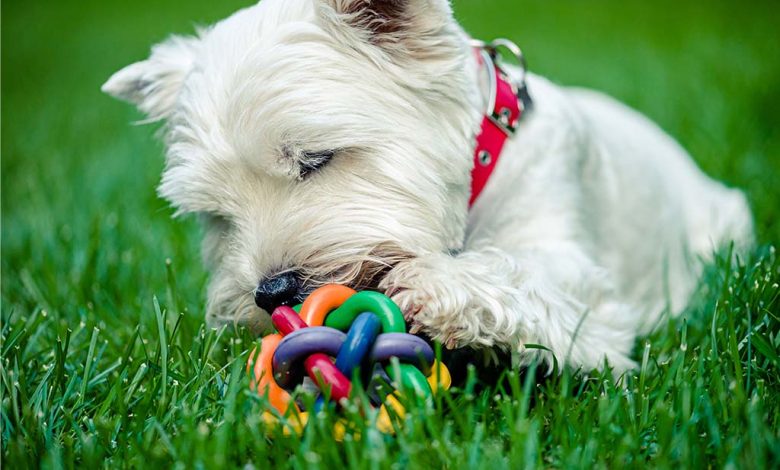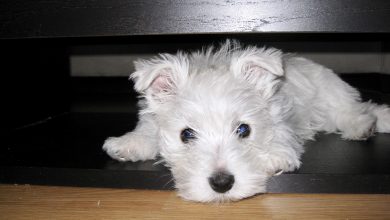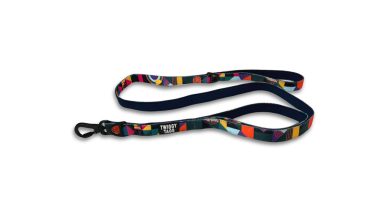“Repeatedly chasing after a ball or toy can result in high levels of adrenaline and cortisol being released. These can leave a dog feeling wired and unable to fully relax, even long after the game has finished.
Toys can be a brilliant source of mental and physical stimulation – and FUN! – for dogs. Without taking care to choose the right toys and use them in the right way, however, toys can pose a risk to our dogs’ health and mental wellbeing. With so many on the market, knowing which ones to choose can feel overwhelming, so read on for top tips on finding the best suited toys for your Westie and avoid common pitfalls and dangers.

Do dogs need toys?
In short, yes! Toys are incredibly valuable in aiding the development of young dogs and providing mental and physical stimulation to dogs of all ages. They’re an excellent source of fun and entertainment, as well as offering an outlet for our dogs’ natural drives. Keeping boredom at bay is one of the best measures you can take to prevent unwanted behaviours (think: chewing furniture, digging in the garden, stealing socks…) from cropping up.
What kind of toys?
Different kinds of toys provide different sorts of stimulation and satisfy different drives within our dogs. It’s important to consider what our dogs were bred to do. Our Westies were originally bred to hunt out rats and other small rodents. They’re super smart and often have strong prey/chase drives. The best kind of toys, with these characteristics in mind, will therefore be ones that challenge their clever brains, allow them to chase and grab something soft and fluffy, and/or let them dig out treasures.

Interactive toys
Tug toys
Having a good game of tug is a brilliant way to let your Westie live out their hunting drives without harming any unsuspecting wildlife! Tug toys also carry the benefit of being a toy reliant on interaction with you. These kinds of activities foster strong dog-owner relationships, as well as offering a great opportunity to train behaviours such as ‘drop’ or ‘give’.
Chase!
The opportunity to chase satisfies another of our dogs’ natural urges and is a great source of physical and mental stimulation, in moderation.
Playing fetch can place a huge strain on a dog’s body. When you picture the burst of activity when the toy is thrown, the leap or bend to grab the toy and the twisting needed to turn back and return to you, it isn’t hard to see how! Physical injuries such as muscle and ligament strains and tears can result from performing these actions repeatedly. Often being so fixated on the item of chase, dogs also don’t always pay attention to where they’re running. This can risk joint sprains and strains as well as broken bones and impact injuries, especially on uneven or slippery ground.
As well as physical injuries, repeatedly chasing after a ball or toy can result in high levels of adrenaline and cortisol being released. These can leave a dog feeling wired and unable to fully relax, even long after the game has finished. It can take days for these levels to return to normal and this can contribute to unwanted behaviours like excessive barking, chewing or destructiveness. Dogs can also become obsessed with the chase and fixate solely on this during their walk, missing lots of opportunities for sniffing and exploration, and may carry on despite feeling fatigued or sore.
Playing fetch is a great activity, as long as it is carried out safely and the time spent playing is limited. Make sure the ground is even and free of hazards before beginning a game, throw from your hand rather than the high-speed ball launchers to limit the speed of the chase, gently build up the intensity of the game to allow your dog’s muscles to warm up, and mix in plenty of other activities such as tug, scent games and puzzle toys.
Independent toys
Chew toys
All dogs have a need to chew that lasts far beyond their teething stage. Chew toys are great for dental hygiene and chewing can be a great outlet for any pent-up energy in our dogs, including anxiety or frustration. When choosing chew toys, it’s very important to consider the strength and material the toy is made from, as well as the strength of our individual dog’s jaws. Providing toys with a variety of textures will help to satisfy the urge to chew and can help keep precious possessions and furniture from being chomped!

Westies can be strong chewers so hardy materials are a must but avoid anything too hard or brittle. Toys should have a little bit of give to prevent cracked teeth and should be large enough that it can’t be accidentally swallowed, but small enough to fit comfortably in your dog’s mouth. Preferences vary between dogs so offering a variety can help narrow down the kind that your dog prefers.
Some dogs enjoy chewing on hard rubber while others favour softer fabric toys. Take care to supervise your dog when they’re chewing and be mindful of squeakers or other small parts that could be swallowed. Removing a toy when you spot signs of damage can help keep your dog safe.

Soft toys
Soft toys are often given a special place in our dogs’ hearts… or totally destroyed! Either way, they can provide a lot of enjoyment for your Westie. Some dogs like to carry around and snuggle with a soft toy, while others immensely enjoy tearing them to pieces. Make sure to use only soft toys designed specifically for dogs to ensure they are safe and monitor any chewing or destruction so you can remove any items that could become a choking hazard. If you have a toy-destroyer in the house, opt for specifically designed ‘tough’ toys which can withstand more chewing, such as the Beco ‘Rough and Tough’ range, or the Outward Hound ‘Invincibles’ collection.
Food/Puzzle toys
Last but not least… Food dispensing or puzzle toys are a great way to keep your dog occupied when you’re not able to interact with them. They encourage our dogs to use their brains and natural sniffing and licking instincts to get at the food which offers great mental stimulation. Examples include classic KONG rubber toys which can be stuffed with a range of food types, Nina Ottosson puzzle feeders and JW Hol-ee Roller fillable balls.
Make sure to choose a toy that is of an appropriate size for your Westie, as well as considering the difficulty of the puzzle you’re giving them – start them off with the easier games and work up to the more advanced puzzles as they get the hang of it.
As Westies often love to dig, Snufflemats can be very popular, allowing them to sniff and dig out the treats hidden among the strips of fabric and satisfying this drive, reducing the chance of them digging up the garden!
Variety is the spice of life – it can be a good idea to have your dog’s toys on a rotation, so they don’t get bored of them all. Swapping out their toys for a different set every few weeks can help to keep their interest – research has shown a strong preference amongst dogs for new objects over familiar ones (Kaulfuss & Mills, 2008) meaning that stashing some toys away for a few weeks can help make them much more interesting when you bring them out again. Ensure you regularly inspect their toys for signs of damage and supervise your dog for safety when they’re chewing or if they have a penchant for tearing their toys apart.
Jessica Barber is the owner of Follow My Lead Training. For more information, visit: www.followmyleadtraining.co.uk






